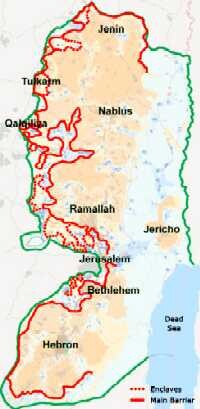B'Tselem 5 November 2003

Simplified map of the separation barrier (Map: B’Tselem, 2003)
The separation barrier will severely infringe the rights of hundreds of thousands of Palestinians. The gross violation of their freedom of movement will restrict their access to work sites, medical treatment, and educational institutions.

Route of the Separation Barrier in the Bethlehem area (Map: B’Tselem, 2003)
On 1 October 2003, the Israeli government approved the new route proposed by the defense establishment for continuation of the separation barrier. In the same decision, the cabinet authorized the prime minister and the defense minister to approve changes in the route at a later date. The text of the decision was announced immediately, but the map of the route was not made available to the public and it took almost a month until it was published.
Approximately 200 kilometers were previously approved by the government, and the majority has already been constructed. The new sections approved by the government cover 270 kilometers, as follows:
Most of the route that was approved and constructed prior to this decision ran within the West Bank. The same is true of the new sections, which in some cases will run even deeper in the West Bank. For example, around the Ariel settlement – the route extends some 22 kilometers east of the Green Line (the Israeli border).
The approved route of the new sections will result in 44 settlements being situated west of the barrier. More than 650,000 dunams (4 dunams = 1 acre), comprising 11.6 percent of the West Bank, will lie between the barrier and the Green Line. Added to this, are the 12 settlements established in East Jerusalem, which comprise 70,000 dunams (1.3 percent of the West Bank).
Setting the route within the West Bank will affect the lives of hundreds of thousands of Palestinians:
Experience in the areas where the separation barrier has already been built shows that construction of the barrier within the West Bank causes widescale infringement of the human rights of Palestinians living nearby.
Hundreds of thousands of Palestinians will have severe difficulty reaching their workplaces, educational institutions, and medical treatment.
It is clear that continued construction of the barrier within the West Bank (in accordance with the Cabinet’s decision of October 2003) will lead to wide-scale infringement of the human rights of the Palestinian residents.
To download the full map (1,669 KB in PDF format) click here.
Related Links: